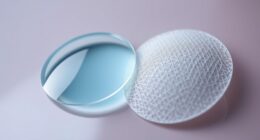Understanding your hair’s porosity helps you know how well it absorbs and retains moisture. To test it, take a clean, dry strand and place it in a glass of room-temperature water; if it sinks quickly, you have high porosity, and if it floats, it’s low porosity. Knowing your porosity allows you to choose the right products and treatments. Continue exploring to learn how to effectively test and treat your hair for healthier, more balanced moisture retention.
Key Takeaways
- Hair porosity indicates how well hair absorbs and retains moisture, affecting product effectiveness and hair health.
- Conduct the water test by placing a clean hair strand in room-temperature water to determine porosity.
- Quickly sinking hair suggests high porosity; floating indicates low porosity; middle sinking hints at normal porosity.
- Treat high porosity hair with heavy creams, oils, and deep conditioning to seal cuticles and lock in moisture.
- Use lightweight products, heat treatments, and clarifying shampoos to improve moisture absorption in low porosity hair.

Understanding hair porosity is key to achieving healthy, manageable hair. When you know your hair’s porosity level, you can tailor your hair care routine to enhance moisture retention and improve product absorption. Hair porosity refers to how well your hair can absorb and retain moisture, which directly impacts how your hair responds to shampoos, conditioners, and styling products. If your hair has high porosity, it tends to absorb products quickly but also loses moisture just as fast, leading to dryness and frizz. On the other hand, low porosity hair resists absorbing moisture, often resulting in product buildup and dullness. Understanding these differences helps you make smarter choices about the products you use and how often you apply them.
To figure out your hair’s porosity, a simple test can be performed at home. Take a few strands of clean, dry hair and place them in a glass of room-temperature water. If the hair sinks quickly, it indicates high porosity because your hair cuticles are open and easily absorb moisture. If the hair floats at the top, your hair likely has low porosity, meaning the cuticles are tightly closed and resist moisture entry. If it sinks slowly or floats in the middle, you probably have normal porosity, which is ideal because your hair retains moisture well while still absorbing products efficiently. This quick test gives you valuable insight into your hair’s structure, so you can adjust your routine accordingly.
Once you know your hair’s porosity level, you can start treating it properly. For high porosity hair, focus on sealing cuticles with heavier creams, oils, or butters that lock in moisture. Deep conditioning treatments with proteins or humectants help fill in damaged cuticles, reducing porosity over time. When applying products, use them generously and allow enough time for absorption, so your hair can retain the moisture it needs. For low porosity hair, avoid heavy products that can sit on the surface and cause buildup. Instead, opt for lightweight leave-ins, heat treatments, or gentle clarifying shampoos to open up the cuticles slightly and improve product absorption. Regularly steaming your hair can also help open cuticles, letting moisture penetrate better.
Frequently Asked Questions
How Often Should I Re-Test My Hair Porosity?
You should re-test your hair porosity every few months, especially if you notice changes in your hair’s response to treatments or products. Regular testing helps you adjust your hair treatment routine to keep your hair healthy. Environmental factors, styling habits, and product use can alter hair porosity over time, so staying updated ensures you choose the right treatments and maintain ideal hair health.
Can Hair Porosity Change Over Time?
Yes, your hair porosity can change over time due to natural hair changes and environmental factors. As you age, your hair’s structure may evolve, affecting how it absorbs and retains moisture. Regularly monitoring your hair porosity helps you adapt your hair care routine accordingly. Keep in mind that factors like heat styling, chemical treatments, and climate can influence your hair porosity evolution, so stay attentive to your hair’s needs.
Is Porosity Testing Suitable for All Hair Types?
They say, “Don’t judge a book by its cover,” and that’s true for hair porosity testing too. Not all tests suit every hair type, especially given the porosity myths and hair porosity history. While it’s useful, some methods work better on certain textures. You should consider your hair’s unique characteristics before testing, and consult a professional if you’re unsure. Porosity testing can guide your care, but it’s not one-size-fits-all.
What Products Are Best for High Porosity Hair?
For high porosity hair, you should choose products that seal in moisture and enhance product compatibility. Look for deep conditioners with protein to help repair damage, and use leave-in conditioners that lock in hydration. Incorporate moisturizing techniques like sealing with oils or creams after applying water-based products. These steps help maintain moisture, reduce frizz, and improve your hair’s overall health, keeping high porosity hair looking vibrant and well-nourished.
How Does Porosity Affect Hair Color Retention?
Your porosity directly impacts hair color retention and dye longevity. High porosity hair tends to absorb color quickly but also loses it faster, leading to quicker hair color fade. Low porosity hair holds dye longer, resulting in more vibrant, lasting color. Understanding your porosity helps you choose the right products and techniques to maximize color retention, so your hair stays beautiful and vibrant longer.
Conclusion
Understanding your hair porosity is like revealing a secret code—once you know it, you hold the key to healthier, more vibrant hair. By testing and treating it correctly, you can transform your hair’s health and beauty. Don’t let your locks be a mystery—embrace the knowledge, and watch your hair flourish as if it’s whispering, “I’ve finally found my perfect care.” So, take charge and let your hair tell its own stunning story.








